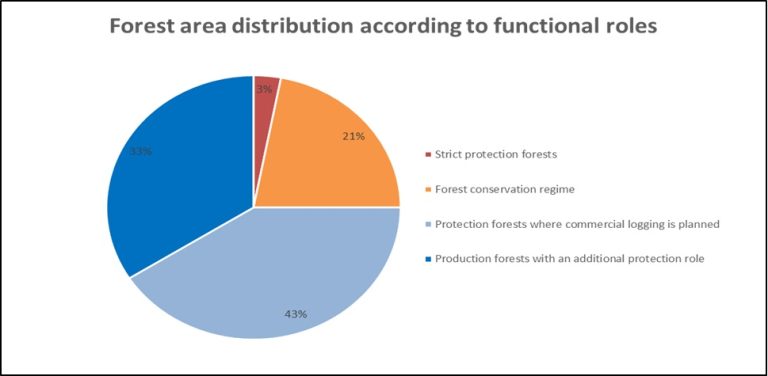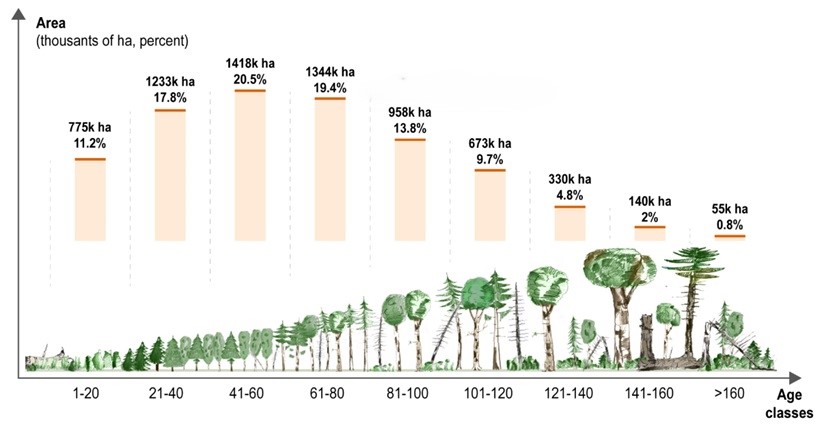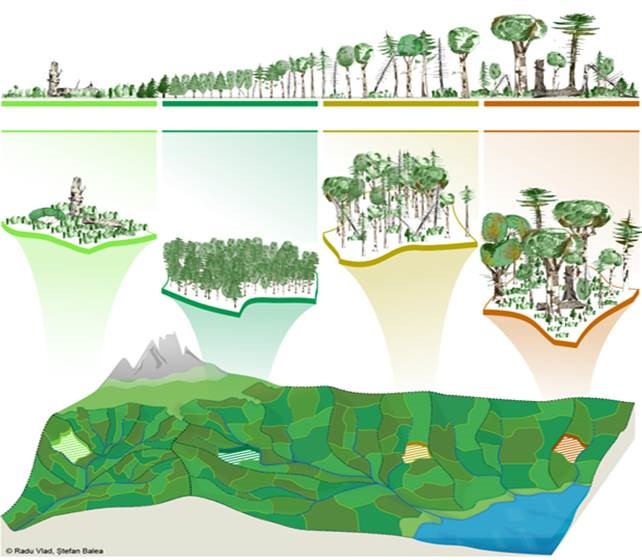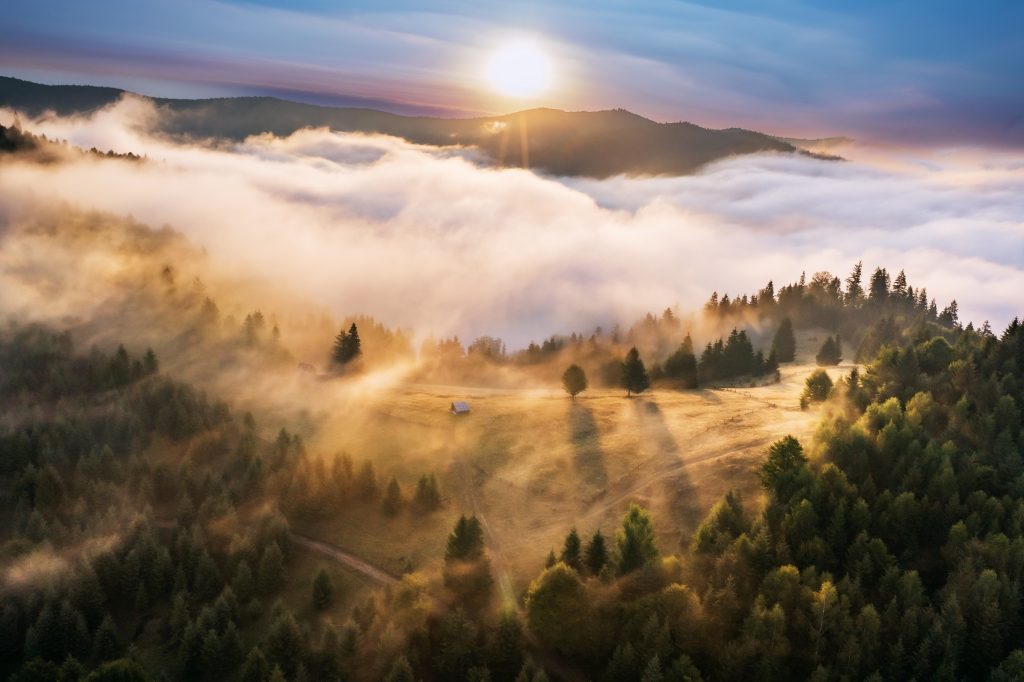We are currently observing the Parliamentary debate in the Senate regarding the New Forestry Code. Unfortunately, our proposals were not considered. Instead of seeing the promised administrative reforms, we notice that good practices in the Romanian forestry are undermined. It is a crucial moment to understand that the status of Romania’s forests as the „green heart of Europe” is not accidental. It is due to the silvicultural practices that have been enforced and consistently applied for almost a century. It is that time in history when we have to defend these good practices which some have never understood and others are quick to destroy in order to flood the market with cheap wood. We need clarity and action now more than ever. This is why we have prepared WWF Romania's Position regarding close to nature silvicultural practices in Romania and multi-century Old-Growth Forests.
Although Romania is renowned for its vast share of old-growth forests (OGF), mature /old forest stands are under-represented in the national forest landscape.
The current unbalanced age classes distribution (Fig. 2) has been significantly influenced by the fact that after the communist period about one million hectares of forests were restituted to over 700.000 private individuals’ owners that were practically also given the opportunity to choose the ones they wanted. As a result, the old exploitable forests providing the largest volume of timber were the most requested. In less than 30 years, most of them were already harvested (legally and illegally).
To put this in perspective, the forests older than 120 years cover an area of 1.5 million hectares in Germany, while in Romania they are only 0.6 million hectares, according to the respective national forest inventories. But the share is going to be improved again for Romania if the long rotation system is maintained. However, the fact that Germany has a larger surface of old-forests does not automatically imply that these forests have better conditions than the Romania ones, as it is reflected by the conservation status of habitats in Natura 2000.
Forests in Numbers. Of the national forest surface:
≅ 76% are productive forests where commercial logging is planned
≅ 21% are under a specific protection regime that does not allow commercial logging
≅ 3% are under strict protection regime
≅ 1% are Old Growth Forests already protected under National Catalog of Virgin and Quasi-virgin forests
According to National Forests Inventory (NFI) 2013-2018, of the total forest area:
- 7.6% are over 120 years old (526.787 ha)
- 9.7% are between 101-120 years old (673.245 ha)
- 13.8% are between 81-100 years old (958.172 ha)
These forests are located in public (48%) as well as private properties (52%).
The previous inventory (NFI 2008-2012) accounted for only 415.081 ha over 120 years old and 587.758 ha between 101-120 years old. This proves that a progressive increase of mature stands is registered when a long rotation system is applied for productive forests.
Old-growth forests vs mature/old stands
The ‘old-growth forest’ concept should not be confused with the ‘mature /old stands’ one.
The old-growth forest stage starts when the biggest trees – which used to be the dominant trees in the stand – reach their senescence and die in an irregular fashion. In Romania, the senescence of most common European species (e.g. beech, silver fir, Norway spruce, oak, etc.) is generally over 300-400 years old in natural conditions.
‘Old-growth forests’ are determined by forestry norms (already from 2012) and the concept is linked to the one of ‘virgin and quasi-virgin forest’, which is defined by specific criteria and indicators considering the national particular conditions. In Romania, these criteria were developed by the national authorities in collaboration with academic environment, civil society and research institutes through a transparent and participatory process, which involved a significant number of stakeholders. It was a long process that started in 2011, following the WWF campaign, and was completed with the elaboration of the procedures for the National Catalog of Virgin and Quasi-virgin Forests in 2016.
The mature/old forest stage starts when, due to loss of a tree, the gaps in the canopy cannot be closed by neighboring trees and therefore enough resources are on the forest floor (e.g. enough light) for natural regeneration to establish (so-called ‘reinitiation stage’). This process generally happens when the trees are 100 – 140 years old and is a typical case of forests in Romania managed with a long rotation cycle.
Mature/old stands result from the implementation of the specific long rotation forest management practices that were systematically applied for productive forests in Romania throughout the centuries. This approach is in line with the close-to-nature forest management guidelines adopted by the European Commission. This practice, imposed by law to all forests regardless of their ownership, allowed the country to achieve a situation in which the vast majority of the actively managed forests will reach the age of 120 years and even more. Although these forests look similar to old-growth ones, they are less than half their physiological age.
Therefore, classifying 120-year-old forests as ‘old-growth’ is wrong in Romania. Those forests are well-managed, to have a ‘close to old-growth’ appearances due to the long rotation systems in use in the country.
Here's why these forests should not be included in ‘strict protection' based on these considerations. If those old/mature forests (7.6% of the forest surface) would be granted the protection status, the forestry system will be forced to adopt shorter rotation periods to manage the rest of the forest (76% of the forest surface), which had the chance -until now- to reach the age of 120-180 years by law. In other words, to save about 500.000 hectares of over 120 year-old forests, another 6.500.000 hectares will never be given the chance to achieve that age. And since time does not stand still, even the old forest set aside will not remain forever old but sooner or later will once again enter the stage of regeneration. Therefore, under these circumstances, it's difficult to predict if and how many mature /old forests or OGF we will have in the future.
The major risk that the Romanian forests are currently facing with the reform of the Forest Code, is the adoption of shorter rotation periods that could double the annual allowable cut (AAC). In this way, much more timber will be available for the primary wood processing industry since those millions of hectares of younger stands that were managed to become close to old-growth will immediately become available for logging.
While the profits of this operation will be earned by few, the costs in terms of climate, biodiversity and generally the environmental and social services, will be suffered by many, at national and regional level.


The Romanian forest management system
Even though it may seem counterintuitive, harvesting trees only when they become old (i.e. ‘secular wood’) is the only way to ensure that productive forests will reach a mature /old stage (and this intentionally planned to ensure their permanence share at the landscape level, even if not necessarily in the same location).

If the present management system is maintained over the next decades, many more stands will become mature with a “close to old-growth” structure and the proportion of old forests within the landscape will increase (See Figure 2 and the evolution over time of the current age class structures).
The simplification and homogenization of European forests in terms of both the number and age of tree species, coupled with shortened rotation cycles, have led to a significant under-representation of mature attributes in forests (check the EC Guidelines on Closer-to-Nature Forest Management). In Romania, this didn’t happen because the ‘closer to nature’ practice has already been applied to manage the productive forests for almost a century.
Box 1: Key lines of the ‘Close-to-nature’ forest management system in Romania
The principles applied by the current forest management system in Romania shows how managed forests can reach close to old-growth Forests structures and might seem as ‘untouched forests’:
- Natural regeneration through the promotion of local genetic provenance. As a result, 72% of the total forest area is regenerated from natural seeds from a tree generation to another.
- Natural Type of Forests to ensure that natural tree composition respects local site conditions. As a result, natural types of forests cover 77% of the total forest area and only 7 % are artificial plantations.
- Long rotation periods. For many species, such as beech, oak, spruce, and fir, the rotation period imposed by the forestry norms is between 100 and 180 years. According to this practice, ten more years should be added when the forest provides specific ecosystem services. In addition, a regeneration period of 20-40 years should be considered for gradual extraction of the initial trees.
- Long period of tranquility (acting like a “rewilding” period). In the last 25-40 years of the rotation period (the last quarter of the rotation), commercial logging is banned and only sanitary logging is planned, limited to 1 m3/year. Recent updates of the norms are banning these sanitary interventions in forests located in Natura 2000 sites. During the „rewilding” period, the structure of the commercial forests becomes more natural, recreating the characteristic attributes of forests in mature stages, like deadwood and tree-related microhabitats. The age classes distribution at national level shows that the zones where long tranquility periods are applied covers about 1,5 million hectares at national level.
- Selection systems. Where “selection system” is applied, large “targeted diameter thresholds” are imposed by the norms up to 1 meter in diameter for fir, spruce and beech. Considering the natural site conditions, these species reach a diameter of 80-100 only after 200-300 years.
- Sustainable harvesting limits. The legal procedure to calculate the Annual Allowable Cut (AAC) is based on continuity principles (sustained yields) and considers forest growth as well as the long term modeling goal to create a balanced age class distribution. Therefore, when there are no forests that reached the end of the rotation period in a forest management unit, no regeneration harvesting will be allowed, with the aim to reverse the under-representation of mature stands. But, in cases when several forest plots have reached the harvesting age at the same time, not all of them will be harvested, as the AAC still sets limits to allow an average forest growth. In this way, the regeneration harvesting of some old forest stands will be postponed to the next decade /decades until they will be included in the harvesting plan in line with the tranquility restrictions imposed. This method allows for some areas to further get older, reaching advanced ages way beyond the rotation period and considering also the commercial logging activities are banned during several decades (see point 4).
As a result of the practices applied by the Romanian forest management system, most of the managed forests achieve a structure that is similar to the old-growth one before starting the regeneration harvesting. For this reason, more criteria and indicators beyond the age of the trees are needed to define old-growth forest in Romania, as the age of a tree cannot help to make the difference with productive forests, which were deliberately managed to achieve a similar structure.
This is in line with the European Commission’s definition of old-growth forests (Commission Guidelines for Defining, Mapping, Monitoring and Strictly Protecting EU Primary and Old-Growth Forest). Moreover, since active management is producing such forests stands which are very similar to old-growth one, such management should be encouraged at European level, and not indirectly discouraged /banned.
However, maintaining this system clearly generates economic losses for forest owners, forest administrators and the primary wood industry. In fact, the net annual increment of wood removed in Romania remains under 37%, while the EU average is around 65%. Not surprisingly, the primary processing industry is lobbying for short rotation periods, that would allow to increase (overnight) the amount of ‘fresh wood’ volumes available on the market.
WWF-Romania’s Position on Old-Growth Forests and Close-to-Nature Forest Management Practices
While protecting the real old-growth forests (OGF), Romania should maintain the existing Close-to-Nature Forest Management Practices (CNFM) in order reestablish a balance regarding the share of mature /old forest stands at the forest landscape, along with their mature attributes. To ensure this, WWF believes that:
(A) Romania needs to protect all its (true) Old-Growth Forests according to legal procedures in line with the National Catalog for Virgin and Quasi-virgin Forest (no matter if they are currently classified as productive forests) and EC Guidelines for Defining, Mapping, Monitoring and Strictly Protecting EU Primary and Old-Growth Forests.
(B) Romanian Closer-to-Nature Forest Management practices for productive forests need to be maintained by the Forestry Code to ensure that all the managed forests will have the chance to reach structures that are close to old-growth. If we maintain the current system that aims at reaching a balanced age class distribution, the share of stands with ‘close to old-growth structures’ will gradually increase at national level, as the way the annual allowable cuts are calculated will not change.
C) The new concept of “secular forests”, introduced by competent authorities, should include the forests that doesn’t fully meet the virgin and quasi-virgin forests definition and do not comply with all criteria and indicators established for the inclusion in the National Catalog, and which should be included under the OGF concept defined by the EC guidelines.
Box 2: “Secular Forests”
To be classified under the “secular forests” concept, forests should: (i) shelter biodiversity values significant at national /regional level OR (ii) provide ecosystem services in critical situations, AND additionally (iii) to fulfill the following conditions:
- Phytocoenosis are native to the site-specific environmental conditions;
- Ecosystems with complex structures in various development stages forming a horizontal mosaic and with a stratified vertical structure;
- Presence of „veteran trees” /”habitat trees” that have reached senescence (dying trees from the oldest cohort because of senescence) is essential;
- Presence of very old trees having above the half of the physiological age (i.e. over 150 – 250 years for main species) and dominants (i.e. min. 35% of the area should be represented by such „very old trees”);
- Occurrence of standing and fallen deadwood in all decay stages and across the entire forest area (with most of the volume coming from the largest trees which have reached their senescence and died);
- Natural density (according to the natural forest type and site conditions);
- Large and compact areas (including stands < 30 ha but preferably > 10 ha, taking into account local seasonal conditions).
These cumulative national specific conditions should be considered considering the national specific and to make a difference from the stands for which there is evidence of active productive management that deliberately design to achieve close to old-growth structures through CNFM practices.
The Way Forward for protecting the most valuable forests for biodiversity
Under the National Recovery and Resilience Plan (NRRP), the Ministry of Environment, Water and Forests is coordinating a project to identify the potential 10% strict protected areas (including all OGF) mandated by the EU Biodiversity Strategy. To do this, it has appointed an independent consortium formed by over 80 experts, which identified a methodology and already shared the first results. With regard to the OGF identification, the national methodology is in line with WWF proposal. According to the ToRs, the final result of the NRRP project has to be delivered by the end of 2025, through a transparent and participatory process.
WWF is actively involved in the process and encourages all interested stakeholders to join and support this process in view of securing the most valuable forests for biodiversity from Romania.

